
The Honda Magna is a cruiser motorcycle made from 1982 to 1988 and 1994 to 2003 and was the second Honda to use their new V4 engine shared with the VF750S Sabre and a few years later a related engine was fitted to the VF750F 'Intercepter', the later models used a retuned engine from the VFR750F with fins added to the outside of the engine. The engine technology and layout was a descendant of Honda's racing V4 machines, such as the NS750 and NR750. The introduction of this engine on the Magna and the Sabre in 1982, was a milestone in the evolution of motorcycles that would culminate in 1983 with the introduction of the Interceptor V4. The V45's performance is comparable to that of Valkyries and Honda's 1800 cc V-twin cruisers. However, its mix of performance, reliability, and refinement was overshadowed by the more powerful 1,098 cc "V65" Magna in 1983.

The Kawasaki GPZ900R is a motorcycle that was manufactured by Kawasaki from 1984 to 2003. It is the earliest member of the Ninja family of sport bikes. The 1984 GPZ900R was a revolutionary design that became the immediate predecessor of the modern-day sport bike. Developed in secret over six years, it was Kawasaki's and the world's first 16-valve liquid-cooled inline four-cylinder motorcycle engine.

The Suzuki Katana is a street motorcycle sold between 1981 and 2006 and then since 2019. It was designed in 1979–1980 by Target Design of Germany for Suzuki.

The Kawasaki Zephyr is a range of retro-styled naked superbikes made in the 1990s in Kawasaki's Z series. All models have transverse air-cooled dual overhead camshaft inline-four engines. There were a number of Zephyr models, in four engine capacities, 400, 550, 750, and 1,100 cc.
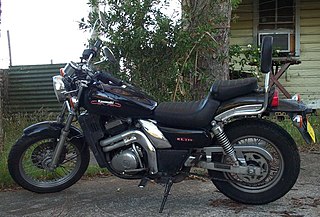
The Kawasaki Eliminator is a cruiser-type motorcycle that has been produced in several variants since its introduction in 1985 as the 900 Eliminator. Currently billed as a "power cruiser", the first two versions of the bike, namely the 1985 Eliminator and 1986 ZL900 models, were almost street replicas of a drag style bike, featuring shaft drive, the ZX900 close-ratio gearbox and forward seating. The engine for both of these machines was the same motor available in the 900ccm Ninja of the same year, albeit with different exhaust and intake configurations.

The Kawasaki Z1 is a four-cylinder, air-cooled, double-overhead camshaft, carbureted, chain-drive motorcycle introduced in 1972 by Kawasaki. Following the introduction of Honda's CB750 in 1968, the Z1 helped popularize the in-line, across-the-frame four-cylinder, a format that became known as the Universal Japanese Motorcycle or UJM.

The Kawasaki Ninja is a name given to several series of Kawasaki sport bikes that started with the 1984 GPZ900R. Kawasaki Heavy Industries trademarked a version of the word Ninja in the form of a wordmark, a stylised script, for use on "motorcycles and spare parts thereof".

The Kawasaki Ninja ZX-9R is a motorcycle in the Ninja sport bike series from Japanese manufacturer Kawasaki, produced from 1994 until 2003. There were five model incarnations across two basic designs.
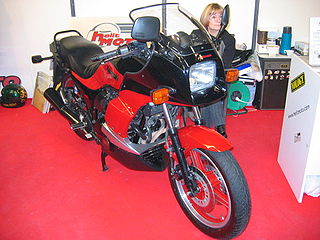
The Kawasaki GPz750 Turbo was a sportbike manufactured from late 1983 to 1985, with two model years – the 1984 E1 and the 1985 E2. Differences were minor, a twin "push/pull" throttle cable for the E2 and different brake caliper stickers. The bike was manufactured in Japan, with parts also shipped to the US and assembled in Kawasaki's Nebraska plant for the US/Canada market to bypass the import tax levied on bikes over 700cc at the time by the US government, a protectionist move designed to save Harley-Davidson which was having financial problems at the time.
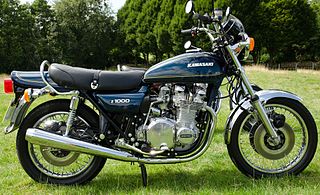
The Kawasaki Kz1000 or Z1000 is a motorcycle made in Japan by Kawasaki, manufacturing commenced in September 1976 for the 1977 model year. The Z1000A1 was an upgraded model to replace the 1976 Kawasaki KZ900 (Z900), which in turn replaced the Z1 launched in 1972 in the Z series. It has an inline-four cylinder engine and a 5-speed transmission, in a 'one down and four up' configuration. Producing about 90 hp, it was one of the fastest production motorcycles of the era. The police model continued in production until 2005.

The Kawasaki GPz750 was a sport bike introduced by Kawasaki in 1982. In comparison with the KZ750, it had many updates focusing on high performance. Changes started at the front, with tapered bearings in the steering head instead of the KZ750's ball bearings, and the upper triple clamp was changed also, giving the GPz solid aluminum clip-on handle grips instead of the traditional handlebar. A bikini fairing almost identical to the one on the GPz550 was added too. The GPz750 had increased power, with slightly higher compression, and camshafts designed to get the valves to full lift quicker, and fitting Mikuni 34mm carburetors for smoother airflow. The cylinder heads were also given a new combustion chamber, and porting and polishing from the factory. An oil-cooler was also added. The GPz750 was the quickest factory 750, as Cycle World recorded a time of 11.93 seconds at 109.62 mph (176.42 km/h) in the 1/4 mile. The GPz750 underwent some significant changes in 1983. The original was based on the 1981 KZ750-E. Kawasaki retired the KZ750 after 1983. The 1983 KZ750L3 was nearly identical to the '82 GPz750, but for different colors, no bikini fairing, and without the porting & polishing in the cylinder head.
The Kawasaki GPz1100 B1 and B2 are motorcycles that were manufactured by Kawasaki in 1981 and 1982 respectively. Both models featured a four-cylinder, two-valve air-cooled engine design with a capacity of 1,089 cc. This engine was an evolution of the powerplant used in the previous Kz1000 series, itself descended from the Z1. In 1983 the GPz1100 was completely revamped in both cosmetic styling, suspension and updated engine. The model number changed to ZX1100A1.

The Kawasaki GPZ1000RX was a motorcycle made by Kawasaki from 1986 to 1988. It had a 997 cc (60.8 cu in) four-cylinder, 16-valve, twin cam engine.

The New Zealand Castrol Six Hour Race was an endurance motorcycle race that was held for fifteen years at Manfeild, Palmerston North from 1974 to 1988. Many of New Zealand's top international riders competed at the Six Hour race; winners included Dave Hiscock, Neil Chivas, Graeme Crosby, Aaron Slight, and Ginger Molloy. The race was characterised by its exclusive use of unmodified standard production motorcycles and a running start where the racers had to run to their machines before they could start. There was special provisions that the machines were no older than 3 years old, which was a boon to the motorcycle industry in New Zealand at the time which saw a dramatic rise in the sale of Motorcycles after these events.
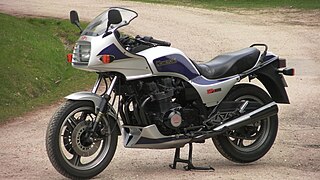
The Kawasaki GPZ1100 is a motorcycle that was manufactured by Kawasaki from 1981 to 1985. All four models featured fuel injection and 1,089 cc engines. All were short lived and were an attempt to fill a market segment that was rapidly changing.
The Kawasaki Z series is a family of standard/naked bikes manufactured by Kawasaki since 1972.
The Kawasaki GPZ1100ABS motorcycle, also labeled GPZ 1100 Horizont, was introduced in 1995. It was a sport touring motorcycle with more focus on touring than sports. Based on a ZZR-1100 motor without the ram air and detuned for more mid-range performance, it also had smaller carburetors and a more restrictive exhaust. The bike was more focused on being economical with budget brakes and suspension. Instead of the Ninjas ZX-11's alloy frame, the bike had a steel double cradle frame with a removable front member for engine removal. The motorcycle had a more relaxed seating position and leg position than the ZX-11D/ZZR-1100 or the air-cooled GPZ1100 of the early 1980s .The official Kawasaki designation was ZX1100E. It also was offered in 1996 as an ABS model.
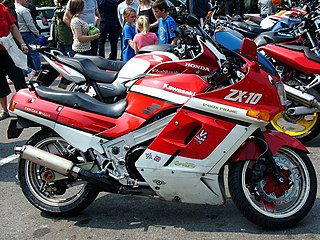
The Ninja ZX-10 was a sport motorcycle manufactured by Kawasaki Motorcycles between 1988 and 1990, part of the Kawasaki Ninja line. With a top speed of 165 miles per hour (266 km/h), it was the fastest production motorcycle in 1988.














